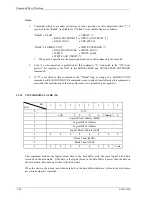
3.3 Format Commands
C141-C010
3-85
a. Header
The top of the format parameter transferred from the INIT is a 4-byte header. The INIT can specify
the method used for defect processing that is executed by this command by control flags within the
header.
•
FOV (format option valid)
0:
Indicates that the INIT does not specially specify concerning the functions specified by the
control flags in bits 6 to 4 of byte 1 (see following “DPRY” to “STPF”.). The IDD
executes format processing in accordance with the default values of the various control
flags. If the INIT specifies “0” in this bit, “0” must be specified in all the control flags in
bits 6 to 4 of byte 1.
1:
Indicates that the INIT is clearly specifying the functions specified by the control flags in
bits 6 to 4 of byte 1 (see following “DPRY” to “STPF”.). The IDD executes format
processing according to the values specified in the various control flags.
•
DPRY (disable primary): Default value: “0”
0:
Specifies execution of format processing using the P List. Alternate blocks are allocated as
substitutes for sectors in which defects registered in the P List exist, and logical data blocks
are not positioned there.
1:
Specifies use of the P List in defect processing. Even if this value is specified, the P List
itself is saved without being erased.
Note:
When the disk media is being initialized for normal operation, the P List must by all means
be used. Therefore, “0” should be specified in this bit.
•
DCRT (disable certification): Default value: “0”
0: Specifies that data block verification be performed after initialization of the disk media.
The IDD confirms that all logical data blocks can be read from normally after initialization
is completed. Any defective data blocks detected in this verify operation are registered as
a C List and alternate blocks are allocated for those data blocks.
1: Indicates that data block verify operations are prohibited after initialization of the disk
media.
•
STPF (stop format): Default value: “1”
When the defect list (P List or G List) necessary for executing the defect processing specified in
this command, cannot be read from the disk media, this bit indicates whether to continue (“0” is
specified) or terminate (“1” is specified) command processing, but in the IDD, this bit’s
specification is disabled, and the specified value is disregarded. When the necessary defect list
cannot be read, this command is terminated with a CHECK CONDITION status. The sense
data at this time indicate “MEDIUM ERROR [=3] / Primary defect list not found [=1C-01]” or
“MEDIUM ERROR [=3] / Defect list error in primary list [=19-02],” if the P List cannot be
read and “MEDIUM ERROR [=3] / Grown defect list not found [=1C-02]” or “MEDIUM
ERROR [=3] / Defect list error in grown list [=19-03],” if the G List cannot be read.
Summary of Contents for 80
Page 4: ...This page is intentionally left blank ...
Page 10: ...This page is intentionally left blank ...
Page 18: ...This page is intentionally left blank ...
Page 62: ...This page is intentionally left blank ...
Page 284: ...Sense Data Error Recovery Methods This page is intentionally left blank ...
Page 296: ...This page is intentionally left blank ...
Page 298: ...This page is intentionally left blank ...
Page 308: ...This page is intentionally left blank ...
Page 309: ......
Page 310: ......
















































